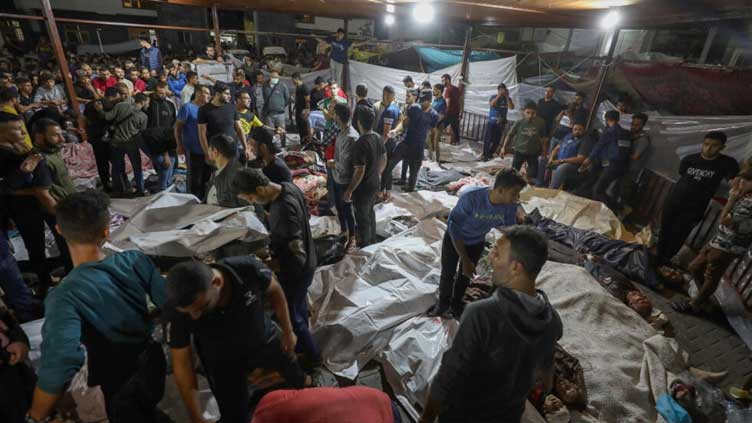Gaza hospitals seemed a safe haven -- then carnage came

World
For tens of thousands of families in Gaza, hospitals became a refuge from endless Israeli shelling
Gaza Strip (Palestinian Territories) (AFP) – For tens of thousands of families in Gaza, hospitals became a refuge from seemingly endless Israeli shelling.
Then came the strike Tuesday night on Ahli Arab hospital in central Gaza, which the health ministry in the Hamas-ruled territory said killed at least 200 people.
The ministry, which blamed Israel for the strike, said Ahli Arab was sheltering not only hundreds of sick and wounded, but also people "forcibly displaced from their homes" because of other strikes.
Gaza residents, who have been told to flee the north of the Palestinian territory, had packed the courtyards and corridors of the territory's overwhelmed hospitals in the belief they were a safe haven from the Israeli bombardments that followed the October 7 attacks by Hamas on southern Israel.

At Nasser hospital, before the Ahli Arab strike, women made bread and spread out clothes to dry in the courtyard of the facility in the southern district of Khan Yunis, as a stream of ambulances brought casualties and surgeons desperately sought to save lives inside.
Amira, 44, and her children were among hundreds to have taken over the courtyard.
"Our bodies itch all over. It has been a week since we could take a shower," she told AFP as she prepared sandwiches for her children with some loaves she had been given.
"Death might be more merciful," she added.
Makeshift mattresses cover the ground and each night the homeless and displaced try to sleep amid the roar of air attacks and the growing cold.
Ibrahim Teyssir is one of thousands to seek refuge around the Dar al-Shifa hospital, the biggest in Gaza and the heart of the medical system for the 2.4 million population. "No one has pity on us," said Teyssir. "What have we done to deserve this? What have our children done?
"Most people are not part of any armed group." "Hospitals are at a breaking point and are overflowing and with people desperately seeking a safe shelter," the World Health Organization added.

"Crowding is getting worse. Over 30,000 people are sheltering at Shifa Hospital alone," the UN agency told AFP, quoting Hamas health ministry figures.
"We are extremely concerned about disease outbreaks due to mass displacement and poor water and sanitation among people who are already in a dire situation."
Safe haven?
The hospitals were attractive because they had been relatively spared from the Israeli bombing raids that have hit Gaza every day since the October 7 attacks in which 1,400 people died in southern Israel.
But the WHO says that 111 medical buildings have been hit, 12 medical workers have been killed and 60 ambulances targeted. About 3,000 people have died in Israeli raids since the since the Hamas attacks, according to the Gaza authorities.
About one million people from northern Gaza have moved to Khan Yunis and other southern districts to avoid the looming Israeli ground offensive.
About 100,000 people are left in the northern district around Gaza City that Israel says is a Hamas stronghold and has warned will be the target of its assault.

Conditions across the tiny territory are worsening every day for the 2.4 million population, according to aid agencies.
UNICEF, the UN children's agency, has said that unless water and fuel are sent "immediately", Gaza inhabitants are in "imminent danger" of epidemics and death. The only crossing to the rest of the world at Rafah is closed.
Egypt has refused to open Rafah even though trucks loaded with aid are waiting on the Egyptian side of the border.
Some shells have fallen on the Gaza side, and Egypt, Israel and the United States have failed to agree a way to open the border gates to let aid in and some foreign nationals out.

Israel has also cut power and water supplies to Gaza. It has partially eased the water blockade, but only a tiny fraction of the daily needs has passed through. Gaza's hospitals say they will struggle to keep operating and the human toll grows every hour.
Hundreds of children are already among the dead and there are 10,000 injured, many packed into the six remaining hospitals. Shortages of medicines have added to the crisis caused by the lack of water and fuel to keep medical establishments running.



